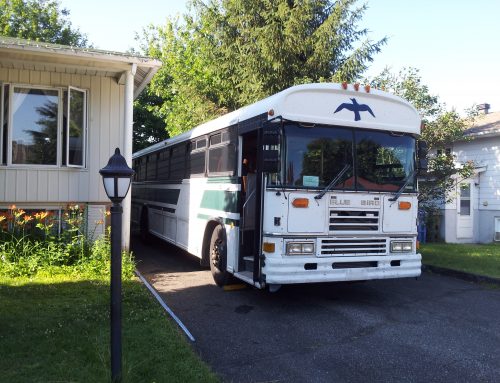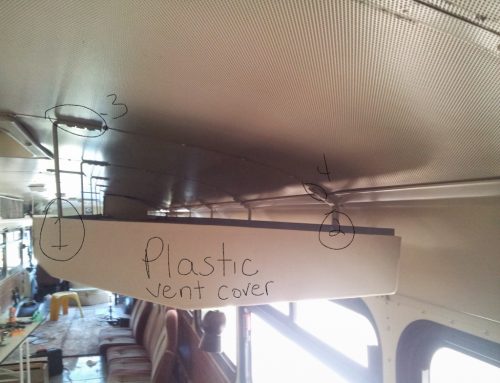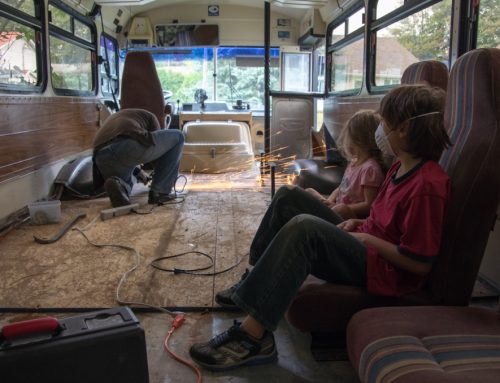Buying a 20 year old, 40ft bus that you have never seen in person may be a bit nutty. Taking the train and driving it 900 km home without knowing if it was 100% mechanically sound (and running into problems) is quite nerve-wracking. Standing in front of said bus as you wait for an inspection to make sure that it is road worthy so you at least try to then get plates, could make your knees buckle a bit.
And that is where we were last week. Inspection and plates.
 We can officially say that the bus is in great condition. There are a few little things that need to be done but the only three things that made it onto the inspection that we needed to get done right away were three lights. One burned out, one a bit rusty and needed new screws to be able to ground and the other a socket that needed to be replaced. That was it… big sigh of relief!
We can officially say that the bus is in great condition. There are a few little things that need to be done but the only three things that made it onto the inspection that we needed to get done right away were three lights. One burned out, one a bit rusty and needed new screws to be able to ground and the other a socket that needed to be replaced. That was it… big sigh of relief!
I followed the mechanic around and asked tons of questions. It is my nature, and though he seemed a bit off put at first he had no problem within a few minutes. As I am very visual so I get a lot out of having things pointed out so going to the mechanic is something I love to do and watch. One of the major things I wanted to know was how to adjust the air brakes which need to be checked once in a while. I had checked on Youtube but being under the bus and seeing it up close was exactly what I needed. As I waited for the inspection to be done the sun was going down and my nervousness shifted again to backing up in our driveway. This time in the dark. I did it though and now there are no more excuses to get to work.
The day after the inspection I headed to the SAAQ for the plates. This was another thing that was making me very nervous. Quebec makes it hard for you to change a title from bus to RV. To get it done you may need an inspection and you must have the following:
- a kitchen that includes: a stove, refrigerator, counter, sink and table;
- sleeping quarters that include: a hide-a-bed or bed;
- a complete bathroom that includes: a bath or shower and a toilet with a permanent hook-up to a drainage system;
- an electrical system that is independent of the vehicle’s motor;
- a propane gas system with a certificate of installation compliance;
- a potable water tank;
- a sewage tank;
- a water heater;
- a heating system that is independent of the vehicle’s motor;
- a minimum of two seats with seatbelts;
- a number of seats with seat belts greater than or equal to the number of places to sleep (maximum nine).
http://www.saaq.gouv.qc.ca/en/road_safety/vehicles/converted_motorhomes/index.php
Of course… our bus has none of these. But the other problem is that we don’t want all of these either. The main thing that would make a problem is the sewage tank or black water tank. We want to have a composting toilet and that would have caused a problem because from what I have heard the inspectors don’t like it.
So, one of the big reasons that I bought a bus 900km away was that it was already titled as an RV. For me, that meant having a bit more freedom with what we want compared to what is “required” and encountering less problems and keeping the possibility open that we could simply use it to move if it came to that. However, after talking to the SAAQ a few times and talking with people, I had doubts as I waited for my turn with all the documents in hand to get my plates. But, confusion by a new staff and a few strategically answered questions made the whole process go over quite smoothly and I walked away with my plates in hand. However, it is not yet on the road. Registration fees for a large vehicle is expensive!! Since I will not be driving it around for fun just yet and have a lot of work to do on it, I decided to keep it off-road. We have year for the inspection to be stil valid so I think that a year is a reasonable goal to get things done.
And so it has started. The first job is getting the back wall out. This bus was a military bus and the back section was for baggage and for weapons. The back wall is made of metal and like the rest of the bus, that means rivets. Oh my… I already hate rivets!
There are a few ways to get Rivets out… The first is to drill the center and then “pop” the head off… (when people say “pop the head off” don’t believe them… it involves a lot of banging and prying) I have seen a few videos that make it look much easier so I might be doing something wrong but these things are HARD!
Here are a few of the rivets that I have gotten off… still more than a thousand to go… yikes!!

The second way to get rivets off is by grinding the head off or making an “X” with the grinder in the head of the rivet and though yes, it is faster. The grinder still scares me with all of those sparks. I have the protection (though I want to find a pair of coveralls) but the grinder is still scary.
The kids are also involved in the bus demo. Xavier has almost gotten all of the baggage hooks off and Colin has helped him and has also unscrewed many screws along with Khéna.
Even Willa has been helping out!
BTW… in the above picture you can see the tight fit in our driveway. We had to take the fence gate off because we are so close to the gate so that our car can also fit.
So, Our goal for the bus right now:
- take out the wall (still have a couple of rivets and it will be done)
- take out the luggage racks (grinding the front posts then rivets)
- take out the floors (there is a soft spot in the back that needs to be checked out)
- take out the walls (more rivets)
- Most likely take out the ceiling… (even more rivets)
Any tips for taking out rivets are appreciated!











You are amazing! It is so exciting to read about how you are doing this! I mean, tears welling up every time I read one of your posts! And not just from the scary bits! I’m over here rooting for you!
Awww…. thank you!
It feels a bit surreal really at times. I am doing it and writing about it but it still doesn’t feel real yet… maybe that is a bit weird. I guess this has been a dream for such a long time and I am used to having dreams that do not come true, that it is hard to realize that with each step I am taking I am actually getting closer to that dream.
Again, it is so awesome what you guys are doing!!!!!!!! Go family Go!!!!!!